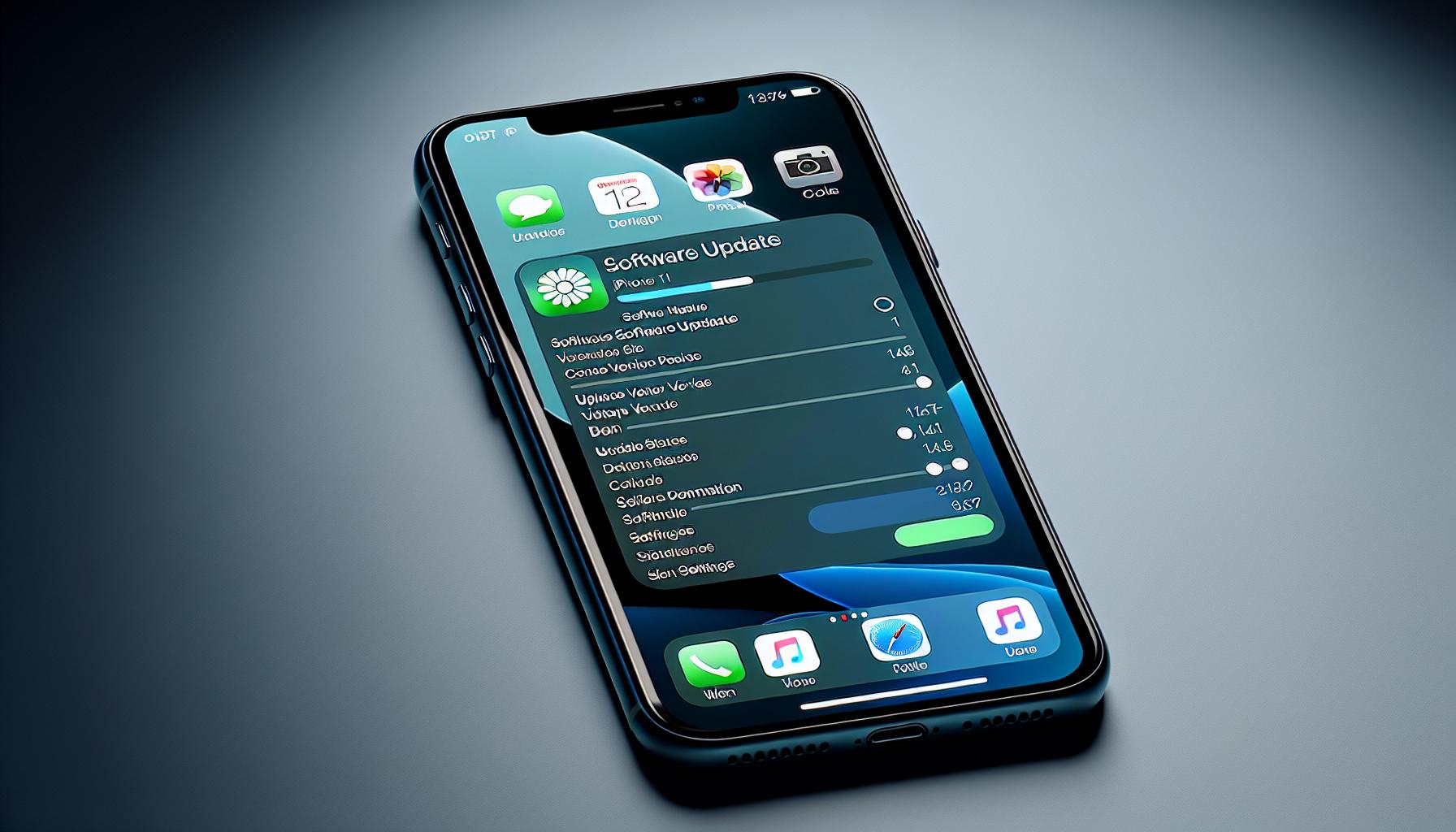Ever found yourself in a sticky situation where your iPhone 11 isn't responding as it should? Don't worry, you're not alone. A hard reset might just be the quick fix you need. It's a simple yet effective way to troubleshoot common problems like a frozen screen or slow response time.
What is a hard reset?
A hard reset, also known as a force restart, is a more drastic action compared to other types of resets. It's not something you’d want to do regularly, but you'd consider it for troubleshooting purposes. When your iPhone 11 is not responding, behaving erratically, or running slow, a hard reset is often the quick fix that gets things back to normal.
This action is equivalent to a forced reboot. It disrupts all tasks and processes that your iPhone is currently undertaking. Consequently, it tends to solve many minor issues that commonly afflict smartphones. Problems such as a frozen screen, slow response times, or simply strange behavior from your apps often clear up after a hard reset. However, don't worry about losing your data. A hard reset is different from a factory reset, which removes all settings, files, and data from your iPhone. A hard reset leaves your data intact.
Actions like these have their place, but shouldn't be your go-to solution. Over-reliance on hard resets can potentially lead to issues down the line. It's best to look at it as an option when your device is not performing as it should, and basic troubleshooting steps have not resolved the issue.
Now that you've become acquainted with what a hard reset is, the following sections will walk you through when and how to perform one on your iPhone 11. By understanding the nature and purpose of a hard reset, you're well-equipped to handle such situations when they arise, maintaining optimum device performance with minimal disruption to your routine. Continue reading to dive deeper into this handy troubleshooting tool.
When should you do a hard reset on your iPhone 11?

The answer is straightforward. When your iPhone 11 is acting up to such an extent that standard troubleshooting doesn't work. These troublesome incidents may be manifested by your device in a range of ways.
For example, let's say your iPhone screen is stuck, or your phone isn't responding to touch inputs. An inescapable app that refuses to close, or your device not powering on despite multiple attempts, are also common red flags indicating the need for a hard reset.
At different times, you might see your iPhone 11 lagging noticeably in response. This could be during typing, opening applications, or even transitioning between screens. You're trying to enjoy some music or a video, but the audio output is garbled beyond recognition. Or perhaps, your phone heats up and drains the battery quicker than usual.
All of the above indicate a potential issue that may be resolved by a hard reset.
While it's important to understand when to execute a hard reset, it's equally essential to realize that it shouldn't be your first response. Over-reliance on hard reset is not beneficial to you or your device's long-term health. Implement basic troubleshooting steps first which include restarting your iPhone, closing unused apps, and updating your device to the latest software version.
Only opt for a hard reset if those basic steps have not helped alleviate the problem.
In the grand scheme of iPhone maintenance, remember this: A hard reset is a quick, potent solution. But it's not a cure-all. It's a necessary asset in your troubleshooting toolkit but it should be your fallback, not your immediate answer.
Keep these concepts in mind to maintain optimal performance and extend the lifespan of your iPhone 11.
Step-by-step guide to perform a hard reset on iPhone 11
Don't worry, it's easier than you think. Here, we've got you a clear, concise guide on how to perform a hard reset on your iPhone 11.
When your device seems unresponsive or certain apps refuse to close, these few simple steps can be your quick fix. However, always remember that a hard reset should not be your first response.
Back up Your Data
This is key. Start by backing up all crucial data. Why? A hard reset can cause data loss. Go to Settings > Your name > iCloud > iCloud Backup. Click Back Up Now. Your data's safe, and you're ready to reset.
Begin the Hard Reset Process
This is how it's done. Firstly, hit the Volume Up button, then quickly press the Volume Down button. Hold down the Side button until the Apple logo shows up on your screen.
Device Turn Off
Don't let go just yet. The screen will eventually turn off. It's important you continue holding the Side button despite the blackout.
Apple Logo Appears
Patiently wait. The Apple logo will in due course reappear, signaling that the phone is restarting. You can now release the Side button.
In case of the unforeseen inevitability that you're stuck in a rut during this process, going to an Apple Support store or contacting their online help desk can navigate your way to the resolution. Dealing with tech can sometimes be a nightmare, but remember, persistent issues could be indicative of a deeper problem that probably requires professional attention. After all, maintaining your iPhone's long-term health is significant and a hard reset is just a quick fix. With these steps, you can handle such situations like a pro.
Alternative methods to reset your iPhone 11
While the step-by-step procedure previously detailed is perfect for most users, sometimes it might not work as expected. Don't worry; there're alternative methods to reset your iPhone 11.
One such option is to utilize iTunes. Connect your iPhone 11 to your computer and launch iTunes. Depending on your settings, you might need to unlock your iPhone and tap 'Trust This Computer'. Select your device in iTunes, click the 'Restore iPhone' button and confirm the action. Bear in mind, this process will wipe all your data. It's vital to have a backup first.
Another alternative at your disposal is using Find My iPhone on iCloud.com. Although this method primarily serves to locate lost or stolen devices, you can also use it to reset your iPhone remotely. Before you proceed, ensure that the 'Find My iPhone' feature is turned on in your device settings. Sign into your account on iCloud.com, click on 'Find iPhone', select your device and click on 'Erase iPhone'. This method also necessitates prior data backup, as all your data will be erased.
One last resort to consider is to enter Recovery Mode. For this, you need to connect your iPhone to your computer and perform the same series of button press combo that initiates a hard reset. Here's the difference: continue to hold down the side button even after the Apple logo appears, until you see the connect to iTunes logo. On your computer, you'll receive a message, instructing you to update or restore your iPhone. Select 'restore' since our aim here is to reset the iPhone.
When considering these options, remember that persistence is key. Also, understand that a reset can offer a quick solution to your iPhone problems. But, should any issues persist, don't hesitate to seek professional assistance. You're not alone! It's always okay to ask for help when needed. Bare in mind, a hard reset often solves the immediate problem, but it may not address deeper, underlying issues in the iPhone's software or hardware.
Tips to avoid the need for a hard reset

While it's essential to know how to do a hard reset of your iPhone 11, it's even more crucial to understand how to prevent getting to that stage. Here are a few handy nuggets of wisdom.
Keep your iPhone updated: Always updating your iPhone ensures you have the latest patches and fixes. These updates frequently mend any known glitches, which reduces the necessity for a hard reset. Are you aware of how to update your device? Simply navigate to 'Settings' > 'General' > 'Software Update' and tap on 'Download and Install' if an update is available.
Regularly close unreponsive apps: Often, apps can become unresponsive and cause your iPhone to freeze. Regularly closing these apps can fend off these issues. To do this, swipe up from the bottom of the screen or double-click the home button, then swipe the app windows away.
Conserve battery life: Sometimes, your phone might shut down or freeze due to low battery life. Here are the key points to extend battery life:
- Reduce screen brightness
- Switch off dynamic backgrounds
- Utilize 'Low Power Mode' when appropriate
Remember, it's better to prevent than repent. And since you're here, that means you're serious about keeping your iPhone in top-notch condition.
Feel free to explore the previous sections if you've missed any details. And, as always, before attempting any significant changes like a hard reset, first ensure your data is safely backed up.
Conclusion
So you've journeyed through the ins and outs of hard resetting your iPhone 11. Remember, it's not a step to be taken lightly. Always make sure you've backed up your data before you dive in. The alternative methods mentioned like iTunes, Find My iPhone on iCloud.com, or Recovery Mode can be handy too. And don't forget those handy tips on how to keep your iPhone running smoothly. Regular updates, closing unresponsive apps, and watching your battery life can help you avoid the need for a hard reset. So here's to keeping your iPhone 11 in top shape!
Frequently Asked Questions
How can I perform a hard reset on an iPhone 11?
This process involves navigating to the 'Settings' app, clicking on 'General', scrolling to 'Reset', and then selecting 'Erase All Content and Settings'. You'd be prompted to enter your passcode and confirm the action.
Why should I backup my data before a hard reset?
Backing up data ensures you do not lose your important files like photos, messages, and contacts. If anything goes wrong during the reset, you can always retrieve your data from the backup.
What are the alternative methods to reset an iPhone 11?
Besides a hard reset, you can use iTunes, Find My iPhone on iCloud.com, or by entering Recovery Mode.
How can I avoid the need for a hard reset?
Keeping your iPhone updated, regularly closing unresponsive apps, and conserving battery life are effective strategies to avoid the need for a hard reset.
Should I always backup my data before attempting any changes?
Yes, it's always a good practice to backup your data before making any significant changes to your device. This ensures that your important files remain safe no matter what happens.




